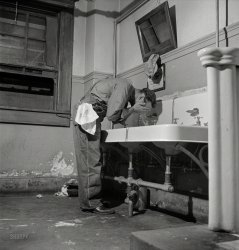
MAY CONTAIN NUTS

Search Shorpy
SHORPY ART

Framed or unframed, desk size to sofa size, printed by us in Arizona and Alabama since 2007. Explore now.
Join and Share
Ad-Free Shorpy
Shorpy is funded by you. Patreon contributors get an ad-free experience.
Learn more.

Recent comments
- Recent view
- Hudson’s Big Store
- Say what??
- Grapes?!
- A Beautiful Moment
- Such joy
- Bethune-Cookman University today...
- Yellow sky at morning
- Side Winder
- Air Quality?
- Sojourner Truth riot
- None were so blind(ed)
- The less famous sister
- Good ol' days?
- Rise and Fall
- Goo Goo Ga Joob
- Ticket Retention
- Not the only one
- Vagaries of War
- Killed by Amtrak
- Back to the Future
- Wanted --
- If you can't stand the light
- Centralized Traffic Control, I believe
- What's really happening
- Heckuva remote control!
- Sometimes — Things Go Bump!
- I SEE THE LIGHT
- Union Switch and Signal Company
- Get That Light Out Of My Eyes
Member Photos
The Shorpy
Print Emporium
Print Emporium
Search Shorpy
Search results -- 30 results per page
- Human Freaks: 1941
- ... Vermont." Next up: Boko the "Alligator Skin Boy." Photo by Jack Delano. View full size.
The Snow Sisters It looks like Elvira Snow ... Posted by Dave - 01/13/2019 - 5:20pm -
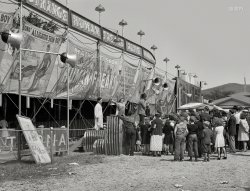
- White Plains: 1941
- ... flying the U.S. and Georgia colors, is attributed to Jack Delano although it bears the notation "Possibly photographed by Marion Post ... Posted by Dave - 08/30/2012 - 12:00pm -
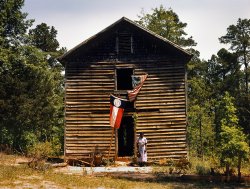
- 10 Million Bushels: 1943
- ... grain. View full size. 4x5 Kodachrome transparency by Jack Delano, Farm Security Administration/OWI.
(The Gallery, Kodachromes, Jack ... Posted by Dave - 08/10/2012 - 4:16pm -
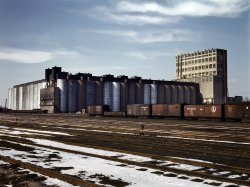
- The Pool Board: 1943
- ... and the order and shift in which they will work." Photo by Jack Delano. View full size.
Wooden box with crank Anyone know what the ... Posted by Dave - 09/29/2013 - 11:41am -
![The Pool Board: 1943 January 1943. "Freight operations on the Indiana Harbor Belt railroad between Chicago and Hammond, Indiana. The engine crew, engineer and fireman report at the roundhouse office to be assigned their engine and given orders for the day. The cylinder at the left is the pool board; it lists the names of the men and the order and shift in which they will work." Photo by Jack Delano. View full size.
Wooden box with crankAnyone know what the wooden box with a crank handle is on the side of the desk over the trashcan? Being over the trash suggests some sort of shredder, but it's hard to imagine what they would have that needs shredding.
A little cranky?@Carey - that is a telephone ringer. Inside the box is a magneto which generates a voltage so the operator knows there is an outgoing call. I used to have one just like this, which had bells on it like the one on the desk laying horizontally. They put out a good kick if you wanted to play a joke on someone.
One long waitThe crank is almost certainly a ringer for the phone system.The wooden box is in character for the elderly, in-house phone set ups. In the early 70's, B&O trackside phones in places had a crank on a wooden box with a mouthpiece from a Laurel and Hardy flick. Penciled inside the cabinet were the different rings, for example "HB Tower:2 short; A Yard:1 long,3 short; HX Tower:1 long, to which a wiseguy added, "...and one long wait!"
To use the phone, first you'd pick it up and make sure it isn't in use, then ring the call for your party,the other end would answer with a short ring and then you talk by pressing a button. [this was to prevent background chatter; it was one big party line...] All of this was made antique collectibles by the radio, even to the removal of the phone lines themselves.
With the callboard nearby, someone in this office is a crewcaller, so the in-house phone line is for talking to the dispatcher, the trainmaster, the engine facility, etc. There also is a phone line to the outside, and if a crewman was within a certain distance from this office, callboys would go out and call at their doors. My name was on a similar board back in the "analog era". I wish I'd saved my peg.
State-of-the-Art CommunicationsThat box with the crank is a magneto generator that produces ringing current of about 108 v.a.c.
It's matched up with the three oak ringers (one on the desk, two on the wall above the window), and the oak 3-hole jack box behind the archboard on the desk. These also work with the three selector boxes between the ringers on the wall.
Apparently he has 3 phone circuits. He chooses the one he wants to use with the jack box. To make an outgoing call, he cranks the magneto. Incoming calls are announced by the ringers, and the selectors control when the ringers announce an incoming call for this office.
Information about railroad telephone equipment of this era, including links to archived user's manuals, can be found here.
If you see oneyou’ve seen 'em all. There must have been a written code somewhere that all railroads subscribed to regarding yard office ambience. They were all the same until recently. Wires and bells and speakers everywhere. Wooden floors, bare bulbs, block phones, doors that closed somewhat tightly, and restroom facilities that challenged the dignity of anyone other than a rail. (The old Humboldt Yard Office of the Milwaukee Road had a urinal that consisted of a large sheet of tin fixed to the wall that one [there were no women in those days] would pee against, and the urine would run down the tin into a horizontal length of rain gutter.) Although I can’t be certain, I’m going to guess the featured picture was taken at the IHB Blue Island yard. The two guys in the window are in their locker room, apparently waiting for a clearance and orders, or getting ready to tie up.
Carbide lampThe bright image in the lower window appears to be a carbide lamp probably an oxweld they were extremely common for that time.
Pool boardHow does the pool board work? Is it meant to be rotated when there's a shift change, so that the current shift is visible and the off-duty shift is on the "dark side"?
What information is being represented? Why are the tags in pairs - is it driver/conductor teams? Does the column of tags with labels represent assignments to trains? Is the Pool In/Pool Out like the bench?
Merch, baby!The Shorpy Store (TM) doesn't seem to stock that attractive Shorpy(R) brand wastebasket... that's a missed revenue opportunity!
The tags.As this photo was taken in a roundhouse/engine terminal office, they'd be paired for an locomotive engineer and fireman. IHB in those days was a terminal/switching road, so the assignments would most likely be for switching jobs or transfer runs.
Pool Board quick [?]On B&O at least, the engineers' pool and conductors' pools were separate. Since one pool had a few more crews than the other, this was necessary.
Engineers pools included a fireman, and later, a trainee, while the conductors turns showed the head brakeman,flagman, and in 1943, maybe a swingman. If a position was vacant, no peg was there. Bulletins were issued weekly advertising vacancies on regular jobs/pool crew and new jobs.
If you look to the right side of that board, those tags seem to show regular train or probably yard assignments; these would show the engineer, fireman, conductor [yard foreman on B&O] and the switchmen.
In practice, if a man was off, i.e. sick or vacation, etc., his tag was removed from his regular assignment and shown in what ever status. Somewhere on that board are extra boards for engineers, road conductors, brakemen, etc. As these extra men are called, their pegs are placed on the appropriate job with its regular men; when their trip is over, they are marked back up on the extra list at the bottom.
Note there is a window behind the board; this way a man can look at the board to see where he "stands" as he marks up, and see where everyone else is too. (The crews were kept on the other side of the window. Time slips, orders, etc. were handed through the "dutch window" above the caller's head.An experienced man could look this board over and tell you what job he's working tomorrow, and what job you're working too.[Sorry, Dave. This is about as quick as I could make this...]
(Technology, The Gallery, Jack Delano, Railroads)](https://www.shorpy.com/files/images/SHORPY_8d24378a.thumbnail.jpg)
- Over the Oconee: 1941
- ... tracks across the Oconee River." Medium format negative by Jack Delano. View full size.
What Are the Odds? Like many others, my ... Posted by Dave - 02/17/2019 - 3:32pm -
![Over the Oconee: 1941 November 1941. "Greene County, Georgia. Railroad tracks across the Oconee River." Medium format negative by Jack Delano. View full size.
What Are the Odds?Like many others, my first speculation at seeing the barrels along the tracks was that it was in case of fire, but why would a train be more prone to catch fire on a bridge, as opposed to solid ground tracks?
[Um, they're worried about the tracks and the bridge catching fire, not the train. - Dave]
Shouldn’t there be water barrels all along railway lines if the danger of fire was so prevalent? Also, just having a bucket to attempt to propel water on the burning locomotive would be an act of futility indeed, given the limited draw of water from the barrels. A man could only draw about a half of a full barrel effectively before the water level became difficult to reach. The collective spitting on the blaze by crew - and passengers, should there be any - might be just as effective. I’m sure other group efforts to extinguish a blaze come to mind, do they not, gentle reader?
Another reader questioned if the railway was elevated. If it isn’t, I bet those knee high telegraph lines to the left afforded a lot of problems of their own: cattle getting tangled up in them; local kids playing on them; you know, typical stuff.
Fire causes: embers falling or flying sparksBy the end of the 19th century wooden bridges in Europe and North America were generally replaced by iron constructions. High maintenance costs of the uncovered bridges and several fires due to embers falling or flying sparks from the engine banned wood as a construction material for bridges in the guidelines of several railway companies, restricting it to branch lines only.
Quote from The Influence of the German Railways on the Birth of Modern Timber Engineering
Click here to view a wooden bridge collapsing caused by a fire.
P.S. Many commenters put questions that are already put, or even answered. So my advice: "Read below the lines."
[That's not why all the comments are asking the same question, Alex. Maybe you can figure it out! - Dave]
Guard railsI think that the two sets of guard rails serve a slightly different purposes. LarryDoyle is right that the outer set (call 'em "timbers" if you like) is unusual in design and look like they are meant to stop a train from sliding laterally off the bridge.
The inner set serves a different purpose, though. Their main function is to support the weight of a derailed train and to spread that weight out over multiple ties to avoid a structural failure. The wheel flanges on a heavy locomotive or train car are essentially rotating blades, with all of the train's weight on a series of 1" long chisel-shaped curved spines, which could easily chew through a wooden tie, particularly if a series of wheels passes over the same spot as a moving train derails. These guard rails support the axles or whatever part of the truck comes to rest on them, and spreads the weight over the structure so that the ties don't give way and train doesn't fall through the bridge or hit its structural parts.
If the inner rails were truly meant to stop lateral movement, they would (should?) have been affixed to the ties with proper chairs or base plates, and have been closer to the running rails, maybe 1.5" or 2" away. You can see what I mean in the picture below, from https://en.wikipedia.org/wiki/Independent_Subway_System#/media/File:BMT_100_Nostalgia_Ride_(19329819685).jpg. There is a guard rail in the middle of the tracks, and a "keeper rail" close to the inside running rail. The keeper rail pushes back on the wheel flange if the trail starts to derail, and forces the truck back into alignment with the curve. Note how strongly it's affixed to the main rail and the track bed.
The barrels of waterare for a fire, and the inside set of rails so the train does not fall off the bridge on derailment, I've often wondered was ever a bridge saved by those barrels?
Now Lake OconeeThis appears to be just east of the railroad bridge over the Oconee River with the Carey Station Road crossing in the distance.
Guard RailsIv'e never seen a bridge with "guard rails" arranged like this one.
In the middle of each triad of rails are the two running rails, which are really the only rails that you ever really want to use when running a train. The other four rails are for safety in case of a derailment.
The innermost pair of the six rails seen are guard rails, nearly always found on bridges, spaced about 6" from the running rails so that a derailed wheelset would drop into the space between them and be held from rolling sideways and going off the side of the bridge.
The outermost pair of rails are called guard "Timbers" and serve the same purpose as the inner guard rails. Can't have too much safety. The guard timbers are usually just that - timbers bolted to the ties. this is the first time I have ever seen old rails tipped on their side and used as guard timbers. Unusual.
A lot going on hereI'm anxiously waiting for an expert to explain what the features are for beyond the track and ties. Are those burn barrels for lights?
Dual useThat's an interesting configuration. A narrow gauge rail on the same ties as the main line.
Questions Questions QuestionsOK, what gives with the multiplicity of rails, the "sideboards," and all the barrels? Looks like this section of track is elevated, or is that an illusion? Flood plain?
BarrelsI suppose, from the absence of a lid, those are water (not sand) barrels for fire suppression from stray embers. Inside would be a bucket with a rounded bottom so as to make it useless for households.
Otherwise wooden trestles would be always burning down.
Tough on litter?Why are there so many trash cans?
Barrels and tracks?Okay, railroad buffs: What are the barrels for? And I would think that the tracks are set for two directions, two rails and an electric line for each direction, but obviously not in use at the same time... Yes?
Barreling along the track.Okay all you railroad buffs, I'll bite.
What are the barrels for? Do they hold sand for rail traction in the winter? For fire in case the trestle catches fire?
Also, why the double sets of rails and what are the outboard uprights for?
Water Barrels? Are the barrels there for water in case the trestle catches fire?
Just CuriousWhat are the barrels for? Anybody know?
[They're full of peach pits and cigar butts. - Dave]
(The Gallery, Boats & Bridges, Jack Delano, Railroads)](https://www.shorpy.com/files/images/SHORPY-8c07604a.thumbnail.jpg)
- Sign of the Cross: 1940
- ... Camden, North Carolina." Medium format acetate negative by Jack Delano for the Farm Security Administration. View full size.
Pie the ... Posted by Dave - 04/30/2021 - 1:23pm -
![Sign of the Cross: 1940 July 1940. "Negroes from Florida and Georgia who travel by car and truck, following the potato crop northward. Migratory agricultural worker has his supper (a nickel pie and a glass of milk) at the railroad crossing at Camden, North Carolina." Medium format acetate negative by Jack Delano for the Farm Security Administration. View full size.
Pie the wayThe young fellow in the foreground looks as if he's posing for an advertisement. His pose, his face, the pie and the milk - - they combine to look as if they are tempting the viewer to indulge, although I'm unsure if the ad would be for milk or pie. By the way, that's a generous slice of pie for a nickel.
[A "nickel pie" is an entire small pie, not a slice. - Dave]
Locomotive TireThat heavy ring protecting the crossing signal is a worn out steam locomotive tire.
Locomotive tires were heated with a circular gas burner to expand them, then shrunk onto the cast driver center. They tended to wear to a hollow tread contour rather than the correct slightly conical surface, which should have a specific fillet radius to the flange. Every time a locomotive spun its wheels, the tires were wearing out of contour.
The tires could be turned a couple times, like brake disks or brake drums, but then were discarded to be melted down. This one escaped the furnace, and makes a nice seat, although usually too hot or too cold.
Also interesting how little grade crossing signals have changed in 81 years.
Model railroaders, take note!
(The Gallery, Agriculture, Jack Delano, Railroads)](https://www.shorpy.com/files/images/SHORPY-8c02723a.thumbnail.jpg)
- Seasonal Greens: 1940
- ... Providence, Rhode Island." Medium format negative by Jack Delano. View full size.
Brown & Sharpe Both my maternal ... Posted by Dave - 12/03/2018 - 11:20am -
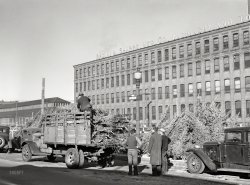
- Gas Demonstration: 1942
- ... after having been sprayed with gas from a plane." Photo by Jack Delano for the Office of War Information. View full size.
Basic ... Posted by Dave - 10/09/2019 - 8:45am -
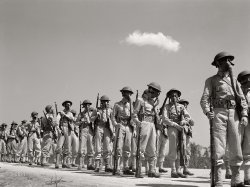
- Gypsy: 1940
- ... of Salisbury, Maryland." Medium format acetate negative by Jack Delano. View full size.
Romani on Delmarva My mom was born in 1935 ... Posted by Dave - 01/10/2018 - 2:41pm -
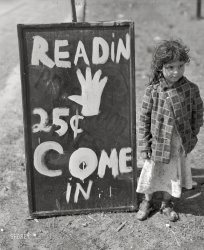
- Spud Ranch: 1940
- ... on a farm near Caribou, Maine." Acetate negative by Jack Delano. View full size.
My guess is -- I thought this might be a ... Posted by Dave - 11/25/2018 - 4:54pm -
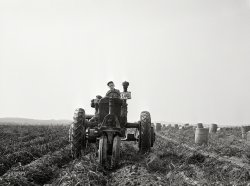
- Always Be Careful: 1942
- ... message comes to us courtesy of Engine 9205A. Photo by Jack Delano, Office of War Information. View full size.
Two engines, single ... Posted by Dave - 09/14/2013 - 9:48am -
![Always Be Careful: 1942 November 1942. "Chicago, Illinois. Giant diesel-electric locomotive at Illinois Central rail yard." The safety message comes to us courtesy of Engine 9205A. Photo by Jack Delano, Office of War Information. View full size.
Two engines, single cabDirectly behind the lead engine, there is what was known as a "mule". These cabless units were used when the consist dictated that more motive power was needed, but not necessarily more crew power. Novel idea, and something that couldn't be done with steam engines because of the manpower needed for each engine.
This locomotiveis actually 2 locomotives called a cow and calf, they are A & B, the A being the cab unit the B has no cab and is controlled by the A unit, I think IC had only two of these locomotives and were used in switching duties.
I am amazed from this photo to find out these type of diesel locomotives even existed let alone the cow/calf type.
Forward or backward?It is usually not difficult to tell which way a steam engine is pointed, but when diesels came along things got more complicated. Out on the road, a train has a designated direction, and when it moves in that direction it is considered to be moving "forward," but what about engines doing switching, either out on the road or in a yard? They have no overall direction, they shift back and forth constantly. Hand signals, whistle/horn signals, even verbal instructions are based on either "forward" or "reverse." But looking at an engine like this one, how do you know which is which? In this case, you could tell by which half has the operating cab (the "A" unit), but that would not work in most cases.
The solution was to label one end of every diesel locomotive with the letter "F", signifying that as the "front" or "forward" end. On this engine, it would have been on the outside corner of the frame, right next to the steps, hand railings ("grab irons"), and that old, anachronistic "pole socket." I think you can just barely make it out in the full-size view.
Cow and CalfAn EMD TR1 cow and calf unit. One of only two pairs built by GM Electro-Motive, both purchased and used by the Illinois Central.
Giant?Hardly. The units are switchers being used in duty on the hump. The cab-less unit behind is known as a slug, or less commonly as a calf, and is controlled by the other using a primitive multiple unit connection, these being the nascent days of diesel technology. Such cow/calf lash-ups never became a common sight in American railroad yards.
EMD TREvidently with a B unit attached. It's a switcher, I wouldn't call it "giant".
Locomotive and slugWhat you're seeing here is two locomotives.
Illinois Central 9205A is a 1000hp EMD NW2 built sometime after 1939. The trailing unit is almost certainly an NW2 but without a control cab and it remains attached to an "A" almost all the time.
No milk from this cowThese are Electro-Motive model NW-2 locomotives, rated at 1000 hp each. Note the trailing unit has no cab. This combination was known as a "Cow and Calf". They were kept together, with the engineer seeing equally well in both directions.
The Chesapeake and Ohio Rwy had a set of engines, nos. 9552-9554-9557 just like this, only theirs had two "calves"; thus they were called a "Cow and a Herd". [I'm not kidding...] They were sent to Baltimore where one unit was taken taken from the set and assigned to another controlling unit. They were powerful, but I didn't care for them otherwise.
No more footboards.The safety slogans are located just above the footboards, which are now illegal due to the inherent danger of crewmen riding at the end of a locomotive. Southern Pacific also used this slogan above their footboards, in addition to "Think Safety Always," "Watch Your Step," and "Look and Live."
TR1 Cow and calf mountainrev's identification of this loco is correct, it's an EMD TR1. Two sets were built in April/May 1941 for the IC, rated at 1350 hp for each unit. They had the machinery of EMD's pioneering FT cab-unit freight locos in a switcher carbody. Later renumbered 1350A&B and 1351A&B, they were scrapped in 1967.
Multiple unit control technology was hardly primitive by 1941 - it had been around since the 1890s, and applied to diesel locos since the 1920s.
(The Gallery, Chicago, Jack Delano, Railroads)](https://www.shorpy.com/files/images/SHORPY_8d23267a.thumbnail.jpg)
- Goggle Glass: 1942
- ... North Western repair shops." Medium-format negative by Jack Delano for the Office of War Information. View full size.
Very chic ... Posted by Dave - 08/30/2014 - 11:58am -
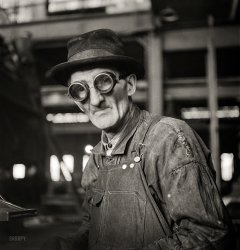
- Dean's Garage: 1941
- ... Heard County, Georgia." Medium format acetate negative by Jack Delano. View full size.
Gas 19¢ but Hot Dogs 5¢!
Nighttime ... Posted by Dave - 11/07/2018 - 10:13pm -
![Dean's Garage: 1941 April 1941. "Gas station in Franklin, nine o'clock in the evening. Heard County, Georgia." Medium format acetate negative by Jack Delano. View full size.
Gas 19¢but Hot Dogs 5¢!
Nighttime tag?Dave, could you please add a nighttime tag for outdoor pictures taken at night? I love pictures like this, and I'd like to be able to search for them.
This is a fantastic shot, taken by one of my favorite photographers. Maybe at the time they were considered mundane, but they're definitely art now.
[Such a tag already exists! - Dave]
Yay! Thanks Dave!
(The Gallery, Gas Stations, Jack Delano, Small Towns)](https://www.shorpy.com/files/images/SHORPY-8c05405a.thumbnail.jpg)
- Klesken Cleans Up: 1943
- ... tracks. View full size. 4x5 Kodachrome transparency by Jack Delano for the Office of War Information.
(The Gallery, Kodachromes, ... Posted by Dave - 08/30/2012 - 3:30pm -
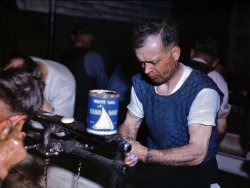
- YouTubers: 1940
- ... the potatoes are harvested." Medium format negative by Jack Delano for the Farm Security Administration. View full size.
Taters ... Posted by Dave - 05/15/2019 - 2:01am -
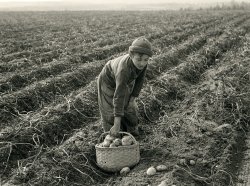
- The Doors of Perception: 1943
- ... Mexico." Next stop, Infinity. Medium-format negative by Jack Delano for the Office of War Information. View full size.
Western Trip ... Posted by Dave - 02/03/2014 - 10:55am -
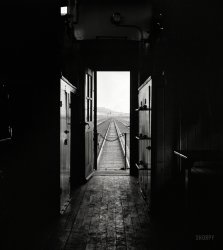
- Fast Food: 1943
- ... Chicago and Chillicothe." Medium-format negative by Jack Delano for the Office of War Information. View full size.
Price of a ... Posted by Dave - 02/07/2014 - 3:19pm -
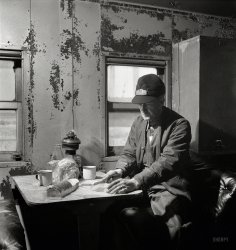
- Stop and Go: 1941
- ... of Brattleboro, Vermont." Medium format negative by Jack Delano for the Farm Security Administration. View full size.
Ford V8 ... Posted by Dave - 02/14/2019 - 2:43pm -
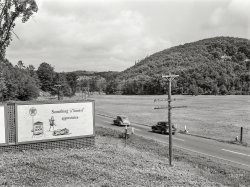
- The Good Earth: 1940
- ... Near Farrington, Chatham County, North Carolina." Photo by Jack Delano for the Farm Security Administration. View full size.
... Posted by Dave - 04/01/2019 - 12:34am -
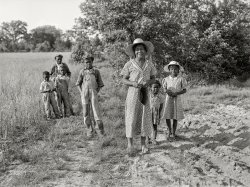
- Winter Wonderland: 1941
- ... Bedford, Massachusetts." 35mm Kodachrome transparency by Jack Delano. View full size.
Fill 'er up! My father used to say men ... Posted by Dave - 05/31/2018 - 10:40am -
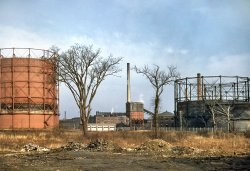
- Tin Man: 1941
- ... Tinplate Company in Washington, Pennsylvania." Photo by Jack Delano for the Farm Security Administration. View full size.
Good job. ... Posted by Dave - 11/05/2019 - 4:15pm -
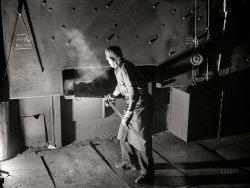
- Danny the Driller: 1942
- ... line." In other words, doing prep work for Rosie. Photo by Jack Delano for the Office of War Information. View full size.
Poor ... Posted by Dave - 05/08/2014 - 12:00am -
![Danny the Driller: 1942 August 1942. "Nashville, Tennessee. Vultee Aircraft Company. Drilling holes for rivets in a fuselage on a sub-assembly line." In other words, doing prep work for Rosie. Photo by Jack Delano for the Office of War Information. View full size.
Poor nutrition?At the start of World War II large numbers of recruits were rejected for health reasons due to poverty-related poor nutrition. Don't forget, this was on the heels of the Depression.
After the war the Federal Student Lunch Program was instituted to provide free or reduced cost lunches to schoolchildren who otherwise might not get a nutritious meal otherwise. This was in fact a Cold-War national-security measure done to ensure that draft-age men were fit for military service.
Now this man looks very fit and muscular even by the standards of the time; he was probably a working man his whole life. He looks older; maybe in his thirties. My grandfather was a fit, young-looking man of 40 when the war started out; he worked in a Pittsburgh steel mill which was a critical defense industry. America needed skilled industrial workers as much as soldiers then, and women couldn't do all of those jobs.
Needed at homeMany, many men fought the war at home in factories, shipyards and on the farm. In Peoria, where I grew up, Caterpillar and Keystone Steel and Wire shifted full tilt into war production, with Cat making Sherman tanks. Pabst Brewery and Hiram Walker Distillery both switched their vats to penicillin production. Boys graduating from high school were exempt from the draft if they were going straight into a war production related job, as above, or many other areas such as transportation/barge traffic or mining.
My dad was a 43 year old single music teacher. He got drafted.
What kept him out?That guy is fitter than 99% of the people any of us know today; there's not an ounce of fat on him.
Makes you wonder what made him 4-F, or which of the other few exemptions he qualified for that were available to an able-bodied man at the time.
[There were thousands of young men working in factories during the war -- there's nothing unusual about his situation. - Dave]
I wasn't questioning his dedication.
[You were questioning "what made him 4-F" or why he's exempt. Like most young men not in service during WW2, he is most likely neither of those things. - Dave]
Prince Valiant?I'm no Vultee expert, but that could be a BT-13 Valiant basic trainer -- or is it a P-66 Vanguard?
Vultee A-31 VengeanceThis appears to be an A-31 Vengeance dive bomber, built in Nashville at the Stinson plant. It was not used in combat by the US, but instead saw service with the RAF, RAAF, and Indian Air Force, in Southeast Asia and the Southwest Pacific. Its only use by the US was as a target tug.
http://en.wikipedia.org/wiki/Vultee_A-31_Vengeance
NamelessI see much to contemplate in this photo. The aircraft, war production, the plant are the obvious points of interest. The man, generally goes unremarkable.
The year is 1942. This man is obviously not in uniform. I wonder why and how he feels not being able to serve in the expected venue. What was the reaction of his fellow workers? Even his less than glamorous position of prep worker for the ubiquitous Rosie makes me wonder how he felt about his own war efforts.
I see him in no less a position of importance to the defense effort, but I speak from the objective position of the present. I would like to have known what his day was like, what he thought and felt other than just the unremarkable man with the drill.
My dad tried to enlist in the Navy early 1942But was rejected because he had flat feet - go figure! So he worked in the war material procurement field throughout the war. There were many vaild reasons why some men were not in uniform.
[The notion that most of men of draft age were serving in the military during WW2 is a mistaken one. Out of the approximately 50 million men registered for the draft during World War 2, only around 10 million, or one in five, were actually under arms. In other words, 80 percent of draft-age men were not in the military during WW2. - Dave]
Dave, believe your numbers are off.Check this out.
http://www.historyshots.com/usarmy/backstory.cfm
Also want to keep in mind the numbers who were drafted/volunteered but were killed, invalided out for sickness/wounds, and who were discharged for other reasons. So the percentage of draft-age men who weren't serving is smaller than might be thought.
[I used numbers from the National World War 2 Museum. If we use the 16 million figure, that means less than a third of the 50 million registered for the draft actually served, with maybe 1 in 4 serving at any given time -- all of those millions weren't serving simultaneously. So young men working in factories weren't some sort of anomaly -- they were far more likely to be doing that than serving in the military. - Dave]
Let's Not AssumeI doubt the guy is feeling unmanned by his job - he's old enough to know better. Fire-eater that I was at 22, by 30 I would have been more than happy if somebody else had volunteered to get shot at.
[Voluntary enlistment ended in 1942. - Dave]
Change ahead?Dec 7, 1941, my dad was a welder in a shipyard, a job I would think would be war essential. Two months later he enlisted in the Marines. You can never tell what will happen.
What kept him out?He could have easily served pre-war and decided that he simply did not wish to re-enlist or participate in the war or could have been wounded and medically discharged in 1941-42.
As a child my father hunted with an old man who was around 20 when the war started and simply chose not to enlist... no one ever came looking for him as his number was never called.
A miracle!This photo is of my dad, John M. Graves, of Whites Creek, Tennessee. Daddy graduated from Joelton High School in 1940. He worked on the family farm and then got a job at the Vultee plant in Nashville. He worked there until late 1942 when he shipped out with the Merchant Marines. He was on a Liberty ship called the Pio Pico which transported materiel to North Africa, Corsica, Sicily, and Italy. After that voyage he came back to Nashville briefly, then signed up for another voyage in the Pacific near the end of the war. He ported in Iwo Jima, Saipan, New Caledonia, and other Pacific islands. He left the maritime service in 1946, moved back home, married my mom, and started a family. I was born in 1954 and Daddy passed away at the young age of 40 in 1962. I have his seaman's papers, as well as his letters home, W-2 forms from Vultee, and more.
His time at Vultee was always a bit of an unknown to me, and of course I never had the chance to hear about his experiences. As I've been working on my genealogy over the years, questions about his job at Vultee came to me often but I never made much effort to find out more. Last week I sat down, did a simple web search for "Vultee plant Nashville", selected "images" for my search results, and saw this photo. I looked at it long and hard, in astonishment. There's no doubt whatsoever that it's Daddy. He didn't wear glasses, but undoubtedly these were issued as eye protection. I'm surprised at how muscular he looks here. Hard work has a way of doing that to a young man. I still cannot believe that he happened to be in the right place at the right time when the photographer came through that day, that the photo was in the archives all these years, that Shorpy picked it up, and that finding it was so easy. Truly a miracle, and I treasure this photo more than you can imagine.
(The Gallery, Aviation, Factories, Jack Delano, Nashville, WW2)](https://www.shorpy.com/files/images/SHORPY-8d00282a.thumbnail.jpg)
- Instant Message: 1942
- ... him with the general office." Medium-format negative by Jack Delano for the Office of War Information. View full size.
No new thing ... Posted by Dave - 04/26/2013 - 11:47am -
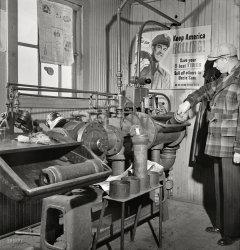
- Old-School: 1940
- ... in one of the one-room schoolhouses." Acetate negative by Jack Delano. View full size.
Seating What kind of chair is this lovely ... Posted by Dave - 01/14/2019 - 9:02pm -
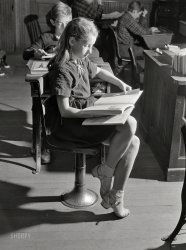
- Ready Player One: 1940
- ... Corporation." Medium format acetate negative by Jack Delano for the Farm Security Administration. View full size.
Red is Red ... Posted by Dave - 04/06/2019 - 9:18pm -
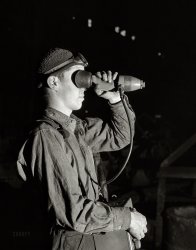
- BRB LOL: 1940
- ... cafe, without the lattes or wifi. 35mm negative by Jack Delano. View full size.
Before cell phones and texting My one cousin ... Posted by Dave - 08/23/2012 - 11:40pm -
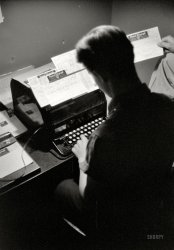
- King of the Road: 1941
- ... North Carolina." Medium format acetate negative by Jack Delano for the Farm Security Administration. View full size.
Old ... Posted by Dave - 12/06/2018 - 12:12pm -
![King of the Road: 1941 March 1941. "Construction worker from Fort Bragg. He lives in this homemade bunkhouse in Manchester, North Carolina." Medium format acetate negative by Jack Delano for the Farm Security Administration. View full size.
Old StreetcarAs evidenced by the destination sign area and light areas on either side. I would not be surprised if this went back to the horse drawn era.
[This is a metal van or bus body that originally would have been mounted on a truck chassis, similar to the vehicles seen here and here. - Dave]
Camp ConstructionThere is an awesome series of photos in the Library of Congress archives taken by Marion Post Wolcott, as I recall, during the early part of 1941, covering the area around Alexandria, Louisiana, at the time several large Army camps were being built in the vicinity. Many of the photos were of construction workers living in similar accommodations as the one shown here.
Despite the Spartan lodgings, I imagine the workers were more than happy to have a steady job after 10-plus years of the Depression.
(The Gallery, Cars, Trucks, Buses, Jack Delano)](https://www.shorpy.com/files/images/SHORPY-8c04843a.thumbnail.jpg)
- Personality Fat Girl: 1938
- ... image. The Library of Congress has another one (photo by Jack Delano) that's even more unique.
Millard and Bulsterbaum! Inside ... Posted by Dave - 02/19/2009 - 2:56am -
![Personality Fat Girl: 1938 August 1938. "Sideshow, county fair, central Ohio." 35mm nitrate negative by Ben Shahn for the Farm Security Administration. View full size.
Jazzy BrollyI really like the carnival barker's sun umbrella. It could easily be sold in Bloomingdale's haberdashery dept. today. One wonders what the colors were.
Huggin' and Chalkin'The posters immediately recall to me Hoagy Carmichael's song hit, recorded by him for Decca in 1946. I first heard it about 1990, sung cheerfully one evening at a dinner party, by a friend in her sixties who remembered it word for word.
Huggin' and Chalkin'
I got a gal who's mighty sweet
Big blue eyes and tiny feet
Her name is Rosabelle Magee
And she tips the scales at three-oh-three.
Oh, gee, but ain't it grand to have a gal so big and fat
That when you go to hug her, you don't know where you're at
You have to take a piece of chalk in your hand
And hug a ways and chalk a mark to see where you began.
One day I was a-huggin' and a-chalkin' and a-chalkin' and a-huggin' away
When I met another fella with some chalk in his hand
A-comin' around the other side - over the mountain! -
A-comin' around the other side.
Where's Jenny Craig?She could make a "big" splash today with advertisements and reality shows.
Proto BoteroThis bewildered me enough for me to do a little research. The artists whose names are on the posters, Millard and Bulsterbaum, were apparently well known for their banners advertising circus midways and Coney Island sideshows -- and also their artistic renderings of zaftig women. I have to admit that though this woman is of majestic dimensions, it's still an oddly flattering image. The Library of Congress has another one (photo by Jack Delano) that's even more unique.
Millard and Bulsterbaum!Inside Jim Secreto’s 8,500-square-foot photography studio in suburban Detroit, rare and unusual works of 20th-century folk art fly from the rafters and emblazon the walls. The rarest and most unusual piece in the collection, "Only 3-Legged Football Player in the World! -- Alive," was acquired from veteran showman and banner connoisseur Kent Danner. "It has incredible provenance," says Secreto, “because it was painted by Millard and Bulsterbaum, who were considered the best in the business.
[The original article by Tricia Vita, from which this paragraph was taken, can be read here.]
LMAOThat's the best comment ever to appear on Shorpy!
Why pay for what you can get freeJust think - at a county fair in central Ohio nowadays, you would not need to pay either a dime (for adults) or a nickel (for kids) to see a girl as fat as the one in the Coney Island produced picture. There'd be plenty of them all around you! (Don't know if they'd have that "personality" though!
Progress?What used to be so rare as to have sideshow status you can now see in the aisles of any Wal-Mart.
County Fairs and CarnivalsThe Old County Fairs and neighborhood carnivals were always great fun. When I was a kid, I couldn't wait for them to come to town every year. Todays kids don't know what they missed. Great side shows, rides, and cotton candy.
The "Too Fat" PolkaAlthough it is definitely not fair that in today's society, the only people we are allowed to make sport of are overweight people (who are never off-limits), this reminds me of a very insulting polka that used to be sung in my youth:
I don't want her, you can have her,
She's too fat for me, she's too fat for me.
I get dizzy, I get numb-o,
When I'm dancing with my jumb jumb jumbo.
I don't want her, you can have her
She's too fat for me, she's too fat,
She's too fat, too fat for me!
Life of the Fat WomanI have to wonder at the life of the fat woman. Did she enjoy touring, seeing new cities? Was she mocked constantly? What a life it must have been.
Not so jolly fat peopleTo a Fat Lady Seen From the Train
O Why do you walk through the fields in gloves,
Missing so much and so much?
O Fat White Woman whom nobody loves,
Why do you walk through the fields in gloves,
When the grasss is soft as the breast of doves
And shivering sweet to the touch?
O Why do you walk through the fields in gloves,
Missing so much and so much?
-- Frances Cornford
This may give some insight to previous anonymous tipster who wondered about the life of the fat lady. You may also watch the movie "What's Eating Gilbert Grape?"
The LadyThe lady was not quite as well trimmed as Millard made her out to be, but she was quite content with her lot. After all, around twenty million of us were either starving or on the verge of starvation at the time, and anyone who could afford a layout was on the road, scuffling for every copper they could get.
For some, it was a suitcase and three pieces of half round secured with a leather thong, the "tripes and keister" of the pitchman. Those who lacked the talent to
"work a tip" did what they could. For the lady, it meant displaying her ample charms up to 16 hours a day, and a 36 hour stretch with very little sleep on tear down and go days.
But seeing new towns? Hardly. A carny hardly had time to leave the lot, and if you did, the locals generally looked at you like you had two heads. Sometimes you saw something that interested you, out of a truck cab, but it was gone by the time you could turn your head to look.
Another View of the Fat GirlAnother view of the same Side Show, with a clearer view the "art." I note that kids could get in to see the Fat Lady for a nickel! During the early 1970s when I was in my early teens, I couldn't get in to the "girly" sideshows. I was just too damned young!
(The Gallery, Ben Shahn, Sports)](https://www.shorpy.com/files/images/8a19009u.thumbnail.jpg)
- 4 Seconds Fast: 1943
- ... This fellow would seem to be sensitive to glare. Photo by Jack Delano for the Office of War Information. View full size.
Fast The ... Posted by Dave - 05/01/2014 - 1:27pm -
![4 Seconds Fast: 1943 March 1943. More Marceline, Missouri. "A dispatcher at work in the Atchison, Topeka & Santa Fe Railroad offices." This fellow would seem to be sensitive to glare. Photo by Jack Delano for the Office of War Information. View full size.
FastThe clock says it's four second fast. I wonder how they (a) know and (b) at what point do they correct it?
Walt DisneyThe Marceline depot is now the Walt Disney Hometown Museum.
http://www.waltdisneymuseum.org/museum/
Judging by the window (double hung sash with a small transom), I would say that it is indeed the same building.
Standard TimeUnder the TT&TO (Timetable and Train Order) system of train operation used by railroads for over a century, timing was critical to keep trains from running into one another. Every railroad had one very accurate "Standard Clock". Every employee whose duties were affected by the TT&TO Rules had to carry a railroad watch, certified annually by an approved jeweler to be accurate to not vary more than 30 seconds per week. Each employee starting on duty was required to compare his watch to a local standard clock at that station, and if it varied more than 30 seconds from the standard to correct it. Each station, the local standard clock had to be compared by telephone or telegraph to the Standard Clock, and if it varied by more than 30 seconds it had to be corrected.
I have that picture on the wall in my hallway!My parents had the picture of the hunting dog (along with three others, forming a set) for as long as I can remember, until they gave them to me back in 1992. I've had them on the wall in my house ever since. One, sadly, was damaged ten years ago when the 1930s era frame simply fell apart suddenly and it crashed down, smashing the glass and slicing the print. The others are still hanging on the wall in our hallway.
Standard Time ZonesWere initially set up by the railroads. Before that each city or region could set its own time and that caused chaos with railroad schedules, and safety.
Housekeeper's holidayBased on this photo, the feather duster must have been invented in 1944.
What gives? It appears as if some major changes were made in this office during March of 1943. Comparing the current image with the previous, we see: 1) the telegraph key has either been moved or eliminated, 2) “Mission Control” has the desk lamp over what appears to be a speaker device missing in “4 Seconds Fast: 1943,” 3) the standard clock is on one wall first, then another subsequently, and 4) in “4 Seconds” the dispatcher has what I’m guessing is a CTC board in front of him, absent in “Mission.” The one comforting constant is the sacred train sheet, spread from one end of the desk to the other. (Well, not so sacred anymore, as train movements are recorded and stored by computer software these days, not pen and ink…at least on Class 1 railroads.)
[The two pictures were taken within minutes of each other, and nothing has moved except the photographer. These are two different desks. - Dave]
Okay Dave, that makes sense. But your answer only raises two more questions: 1) why are there two desks for the same territory (a sure prescription for disaster), and 2) why does the "Mission" board go to Chicago from left to right, and the "4 Second" board go Kansas City (?) to Chicago right to left?
Face to FaceDave - your comment about being different desks is correct. In fact, they appear to be facing each other. Note the position and shape of the "poster board" tied to the pipe above them.
RE: left to right and right to left"why does the "Mission" board go to Chicago from left to right, and the "4 Second" board go Kansas City (?) to Chicago right to left?"
I would guess that "4 Seconds Fast" guy is seated facing south with Chicago to his left and "Mission Control" guy is facing north.
(Technology, The Gallery, Jack Delano, Railroads)](https://www.shorpy.com/files/images/SHORPY_8d26441u.thumbnail.jpg)
- Work, Read, Wash: 1943
- ... room in the Santa Fe yard." Medium-format negative by Jack Delano for the Office of War Information. View full size.
Santa Fe ... Posted by Dave - 07/29/2016 - 8:13pm -
